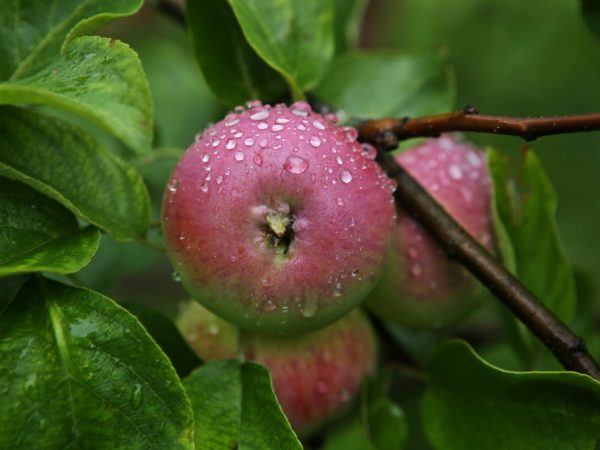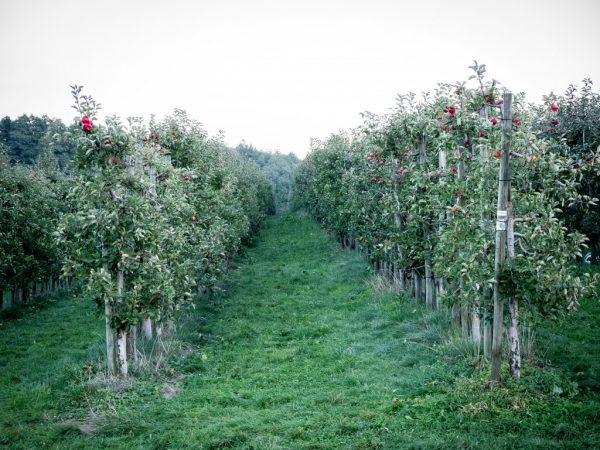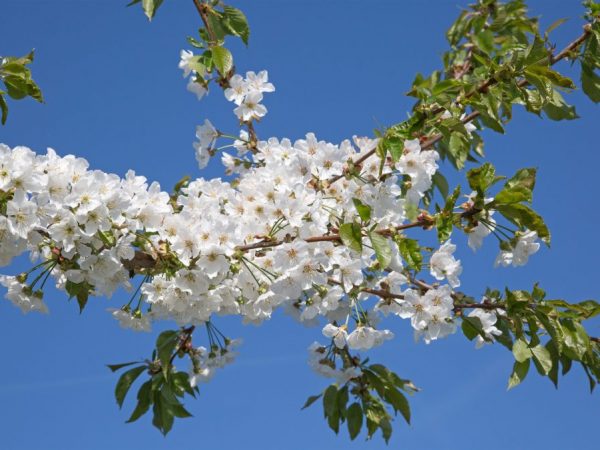Growing an apple tree Borovinka
The apple tree Borovinka has long won popular love not only in Russia, but also far beyond its borders. Gardeners and scientists do not have any data on the origin of the variety, therefore it is generally accepted that nature created it.
- Variety characteristic
- Description of the tree and fruit
- Advantages and disadvantages
- Yield
- Self-fertility
- Disease resistance
- Landing
- Timing
- Landing
- Care
- Watering
- Top dressing
- Pruning
- Reproduction
- Pollinating varieties
- Ripening and fruiting
- The beginning of fruiting
- Flowering and ripening terms
- Periodicity
- Harvesting and storage
- Prevention of diseases and pests
- Growing in different regions
- Ural
- Siberia
- Belarus
- Reviews of gardeners

Growing an apple tree Borovinka
Variety characteristic
There are 2 versions of the origin of the variety name:
- the first trees were found in the pine forest;
- the variety was named after the Russian gardener Bravin.
Description of the tree and fruit
Medium height tree. For 18-20 years, it can grow up to 5 m. The crown is round and not too dense, reaches about 5.5 m in diameter. The leaves are large, oval, smooth, dark green in color. The flowers are medium in size, white and white-pink.
Borovinka apples have a standard round shape and medium size.
Fruits are smooth, light green in color with pink streaks. The pulp is beige, slightly tough and sweet and sour, sourness prevails due to the high concentration of vitamin C. The weight of the fruit is about 100-150 g.
Advantages and disadvantages
This variety has many advantages:
- trees are unpretentious to care for, they can grow in areas with different climatic conditions;
- begin to bear fruit early and give a rich harvest throughout life;
- have high resistance to cold;
- apples are ideal for transportation;
- keep a fresh look until mid-winter;
- good for fresh consumption and conservation;
- the variety is resistant to diseases and various pests, which is especially appreciated by gardeners.
The disadvantages include:
- inconsistent fruiting;
- sour taste of apples;
- the tree's vulnerability to drought - under such weather conditions, it drops unripe fruits in order to preserve itself.
Yield
The Borovinka apple variety has a particularly rich harvest. Average indicators, subject to the rules of care - 100 kg per tree. In the most fruitful years, up to 200 kg were harvested from one adult apple tree.
Self-fertility

Borovinka variety is self-fertile
In the garden where you want to grow such a tree, it is imperative to plant pollinating varieties, because this species is self-fertile.
Disease resistance
For this quality, gardeners especially love this variety, because it is resistant to many diseases. Scab is the only ailment that can infect Borovinka.
Landing
It will even be possible to grow a Borovinka apple tree from seeds, but in this case one cannot be sure of the taste and size of the fruit. It is better to purchase seedlings in those places where they are grown. Faster fruits will give 2-year-old trees. Their roots should not be overdried and have traces of rot. The seedling should look good.
If you bought a young tree with a closed root, then plant it at any time.If open, you need to plant it immediately or put it in the water until it is planted. For planting, choose loamy soil or black soil.
Timing
The best time for planting is autumn. Then the seedlings adapt well. In this case, the hole is dug a month before planting. If you decide to plant an apple tree in the spring, then the pit is made in the fall.
Landing
The hole should be about 60 cm deep and about 1 m in diameter. Up to 15 cm, the hole should take up drainage. Fertilizers are mixed with soil.
For one pit you will need:
- 4-6 kg of manure;
- up to 100 g of phosphates;
- up to 10 kg of peat;
- 1 kg of wood ash;
- up to 50 g of potassium sulfate.
A stick should be driven in the center of the hole. It is better to plant an apple tree together, so that one holds the tree, and the other covers it with earth. The seedling sometimes needs to be shaken so that the earth fills all the cracks.
After that, the earth should be trampled around the tree and another layer of earth should be poured. Tie the trunk to a stick to keep it stable against the wind. the seedling is weak and can break with strong gusts.
Then water the tree generously so that the earth is well saturated with moisture. The first bucket should be poured completely, and then 2 more, intermittently.
Care
Apple trees Borovinka do not require special care, but it is important to follow a number of rules in order to get a good harvest.
Watering

In dry weather, the number of watering increases
Watering is carried out according to the standard scheme - three times a year:
- in spring - a week before sap flow (March 1-5) or during the period of abundant sap flow (March 20 - April 10);
- in summer - in the hottest month (July 15-20);
- in the fall - immediately after harvest (September 20-25).
If the weather is too dry and hot, the Borovinka apple tree is watered with 2 buckets of water, otherwise the fruits will crumble from it. This should be done at least 4 times a week. After watering or rain, the soil around the trunk must be fluffed up, so the roots will receive more air.
After that, cover the soil with mulch, humus or peat so that less grass grows and the soil does not dry out.
Top dressing
In the fall, the tree trunk circle must be dug up and compost or humus added to it. It is better to start feeding in the second year.
The simplest replenishment method is to combine fertilization with irrigation. To do this, prepare a solution based on bird droppings and wood ash:
- 2 kg of wood ash is mixed with 2 kg of poultry manure;
- the mixture is diluted in 10 liters of warm water;
- leave for a day;
- after 24 hours, the mixture is stirred and poured over the tree.
To make the apple tree stronger and give a rich harvest, you can also fertilize it:
- potassium;
- phosphorus;
- nitrogen;
- urea.
All top dressing is recommended to be applied in liquid form at the time of watering.
Pruning
Before planting, the young tree must be cut by a third so that it begins to form a crown faster. With the arrival of spring, it must be shortened and all dry bark removed from the tree. Frozen and broken branches should be removed. This must be repeated 2 times with an interval of 2 weeks.
In the fall, after harvesting, it is necessary to remove all broken branches. To form a beautiful crown, you should choose the 5 strongest branches that do not lie on top of each other. They are made shorter, and the remaining branches are cut off. Then every year weak and improperly growing branches should be removed.
In one procedure, it is recommended to cut no more than 30% of the branches.
Reproduction
You can propagate the Borovinka apple tree by seeds and by vegetation. If you choose seeds, then they can lose the qualities inherent in this variety, because cross-pollination may occur. Therefore, for growing a tree, it is better to graft cuttings or individual buds.
Pollinating varieties

The tree needs pollinators
As pollinators, you can plant the varieties Papirovka, Anis, Antonovka, Cinnamon striped, Astrakhan white or red.
Ripening and fruiting
The Borovinka apple tree has its own characteristics, and it is important to familiarize yourself with them before planting.
The beginning of fruiting
The tree begins to bear fruit in the 4th year after planting, and sometimes even in the 6th year, this is influenced by the climate, feeding and care. Apples grow on all parts of the tree, regardless of age, they can appear even on old growths.
Flowering and ripening terms
The lower branches bloom earlier. Long flowering will ensure a good harvest even with late spring frosts.
Periodicity
One of the disadvantages is the frequency of fruiting of the apple tree. Therefore, in order not to be left without a crop, it is worth having several more types of trees in the garden.
The periodicity comes gradually. At first, the tree may not bear fruit for 1 year, then 2, etc. This is due to a large number of flower buds and a high yield with slow progressive growth. To get apples, buds should be laid on the tree every year, simultaneously with the growth of fruits in the current year.
Harvesting and storage
In warmer regions, the harvest is harvested at the end of August, in colder regions - in September.
You can store the fruits until mid-winter. The fruits of the apple tree must be laid out in boxes or other containers in rows. Then they should be covered with sawdust. The apples should be folded with the stalks up. Instead of using sawdust, you can wrap each fruit in paper.
Room humidity should be up to 95% and temperature around 1 ° C.
Prevention of diseases and pests
According to the description, the variety is practically not exposed to pests and diseases, but prevention is needed. Before the buds swell, the tree is treated with copper sulfate - 200 g of the substance is diluted in 10 liters of water.
Before budding, the apple tree should be treated with 3-4% Bordeaux liquid. For preventive purposes, Topaz or Skor is suitable. After flowering, the crown can be treated with the "Karbofos" insect repellent.
Growing in different regions

The variety of apple trees is chosen due to the climate.
In different regions, the Borovinka apple tree is distinguished by the peculiarities of cultivation.
Ural
Borovinka is the red one that has taken root most well in this region. it is very resistant to cold weather. Most often, these apple trees are grown in large orchards for sale, but many gardeners have also appreciated the advantages of this variety.
Siberia
Because this region is one of the coldest, gardeners are advised to give preference to stanza cultivation. For the winter, you need to wrap the tree up to help keep it warm. The apple tree "loves" moisture, so you can cover the trunk circle with snow.
Belarus
This area is suitable for growing such fruit crops. It is characterized by excellent conditions, so there are no peculiarities when cultivating an apple tree. It is worth adhering to the basic recommendations for planting and further care. Belarusians especially love preservation of these apples: preserves and jams.
Reviews of gardeners
Almost all gardeners are very happy with the Borovinka apple tree. It is noted that the tree is rich in fruits, sometimes branches can even break from weight. To prevent this, you need to make props or strengthen the apple tree.
The fruits of this variety are suitable for making jams, jams, compotes, fresh they are sour and not everyone likes.

